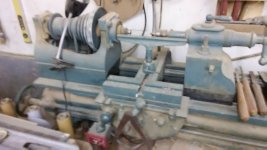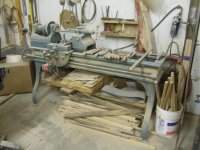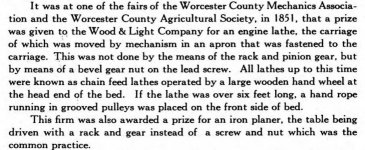Joe in NH
Diamond
- Joined
- Jul 28, 2007
- Location
- Stratham, Cow Hampshire
Billed as a heroic wood turning lathe.
Thayer & Houghton are notable as being a 1.5 generation Worcester, MA lathe builder, one of the first builders attempting any volume of production and ALMOST to the point of interchangeability in lathe construction.
Also the originator of the current lathe setup of separated lead screw/feed rod with the flexibility this allowed. A machinist of T&H's 1853 pioneer lathe would feel quite at home in front of most modern manual lathes.
This one appeared on Craiglist and it would seem this one survived because of large swing and various modifications aimed at wood turning. Peter (of this board) owned for a while a similar lathe which was marked by the maker with the usual headstock badge. This one is not.
Lest you start drooling in anticipation of a notable find (i.e. oldest 500 lathes extant kind of thought) keep in mind this one appears heavily modified in the spindle bearing/pulley/headstock/back-gear area. All driven by a conversion to higher speed required for wood turning.
Which is too bad - as dimensionally and stylewise it would otherwise fit quite nicely in my 19th century machine shop.
Anyway, for future reference. I would guess this one about 1860ish. Perhaps a bit later as New York Steam Engine Works who bought assets of and continued business of T&H in 1862.
Craigslist at Heavy Duty Wood Lathe - tools - by owner - sale



Best pix:

I will pass on this one. But it has many of the hallmarks of "early." And I do enjoy seeing early.
Joe in NH
Thayer & Houghton are notable as being a 1.5 generation Worcester, MA lathe builder, one of the first builders attempting any volume of production and ALMOST to the point of interchangeability in lathe construction.
Also the originator of the current lathe setup of separated lead screw/feed rod with the flexibility this allowed. A machinist of T&H's 1853 pioneer lathe would feel quite at home in front of most modern manual lathes.
This one appeared on Craiglist and it would seem this one survived because of large swing and various modifications aimed at wood turning. Peter (of this board) owned for a while a similar lathe which was marked by the maker with the usual headstock badge. This one is not.
Lest you start drooling in anticipation of a notable find (i.e. oldest 500 lathes extant kind of thought) keep in mind this one appears heavily modified in the spindle bearing/pulley/headstock/back-gear area. All driven by a conversion to higher speed required for wood turning.
Which is too bad - as dimensionally and stylewise it would otherwise fit quite nicely in my 19th century machine shop.
Anyway, for future reference. I would guess this one about 1860ish. Perhaps a bit later as New York Steam Engine Works who bought assets of and continued business of T&H in 1862.
Craigslist at Heavy Duty Wood Lathe - tools - by owner - sale



Best pix:

I will pass on this one. But it has many of the hallmarks of "early." And I do enjoy seeing early.
Joe in NH






